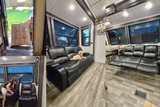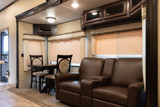3 Steps to Flat Towing with an RV
Anyone who has tried parking an RV on a busy street or crowded parking lot can appreciate the practicality of bringing a second car. But what’s the best way to tow it? Flat towing, also know as four-down or dinghy towing, is a popular method due to the ease of connecting and disconnecting the vehicle and because of its relatively low cost compared to other methods. Here’s the basic steps to start flat towing your vehicle.
1. Check the Manuals
While flat-towing is a pretty straightforward process, it can cause a lot of damage if done improperly or with the wrong vehicle. Not all makes and models can be flat-towed without modification, which is one of the reasons you will see so many Jeeps and Honda CRV’s being pulled behind motorhomes. The vehicle owner’s manual will tell you if your vehicle is suitable for flat-towing and if any special precautions need to be taken. Also, Be sure to check the manual for the motorhome to find the maximum towing capacity.
2. Install the Tow Kit
Once you’ve made sure that both car and coach can handle the towing, it’s time to get a tow Kit. There are several companies and models to choose from, all with their own pros and cons, and available options. Any tow kit should have at least three main parts; a mount, which attaches to the RV’s receiver hitch, a base plate, which is installed on the front or bottom of the vehicle to be towed, and a tow bar, which connects the two. A good tow kit should also include chains or cables that prevent the towed vehicle from separating from the RV if one of the components detaches for some reason. Safety chains are usually required by law and are always recommended for safe towing.
Installing a tow kit can be difficult, and most manufactures recommend having a professional mount the base plate to the vehicle, as it may require modification to the body or other components.
3. Brakes and Wiring
So now that your vehicle is hooked up to the back of the RV, it’s time to wire up the lights and brakes. There are a few different lighting systems available, but most of them work very similar to trailer lights and plug into a socket in the rear of the RV. The lights themselves may be the existing brake lights or another set attached to the outside of the vehicle.
Supplemental brakes are required by law in many states for a reason; they substantially reduce braking distance, making towing significantly safer. Besides the matter of safety, supplementary brakes also reduce the wear on your vehicles, and are a good idea whether legally required or not. As with tow kits and wiring systems, there are a variety of different supplemental braking systems. Make sure to find one that meets your needs and have it professionally installed if necessary.
Once everything is installed and you’re ready to hit the road, start off by driving around a familiar area. it may take a little practice to get used to making turns with the additional length from the towed vehicle. Also, it’s important to remember that braking and acceleration may also be affected so start off slow and make sure you’re used to towing before driving in congested or unfamiliar roadways.
Recent Posts
-
Traveling to the RV Hall of Fame in Elkhart, IN
If you are traveling to Elkhart, IN to see the RV Hall of Fame, getting off the toll road at exit 96 …Nov 14, 2025 -
Best RV Air Conditioners of 2025: An Expert Guide From RecPro
Quick Answers Best overall RV air conditioner: RecPro 15K Quiet AC with Heat Pump (RP-AC3800) Best f …Oct 29, 2025 -
The Nuclear Nomads Expand Sofa with New Recliner Section Install
The Nuclear Nomads are a full time RV family living in south Florida. Andi and Joey value quality ti …Oct 24, 2025 -
Trailer Wiring Guide: How to Wire Your Trailer for Safety and Efficiency
Table of Contents 1. Common Types of Trailer Connectors 2. Trailer Wiring Diagrams: Color Codes and …Aug 20, 2024 -
How to Keep Your Pets Safe While Camping
RVing and camping are a great getaway from the hustle and bustle of work and the city and the day-to …Jul 02, 2024 -
Why Replace Your RV Furniture?
You may wonder when is the best time to replace your RV furniture. There is no one right answer to t …May 20, 2024







